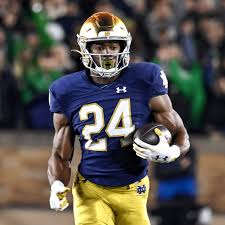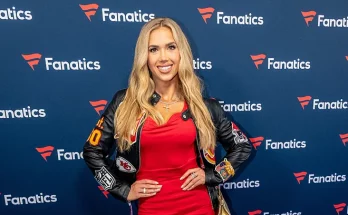When you think about the cornerstones of Notre Dame Football, a few images often come to mind — gold helmets gleaming under the stadium lights, dominant offensive linemen paving lanes for bruising backs, and a commitment to physical football that refuses to fade with time. As the Fighting Irish head into the 2025 season, there’s one position group that has firmly captured national attention: the running back room.
Loaded with depth, versatility, and explosiveness, Notre Dame’s stable of backs isn’t just strong — it’s arguably among the best in the country. After an impressive showing during spring practices, this group is primed to be the backbone of the Irish offense and perhaps the key to unlocking a championship-level season.
At the heart of the conversation is Audric Estimé, the powerful senior who has already carved out a legacy as one of Notre Dame’s most dependable and physical runners in recent memory. At 5-foot-11 and 227 pounds, Estimé brings a punishing style that wears down defenders over four quarters. His blend of downhill power, surprising agility, and improved vision has made him the go-to option in critical moments, and in 2025, he enters the season as a true workhorse with All-American upside.
But what makes this running back room special isn’t just Estimé — it’s the complete unit surrounding him.
Jadarian Price, now fully healthy and looking more explosive than ever, offers a different kind of threat out of the backfield. His smooth running style, combined with elite burst and soft hands, make him a valuable dual-threat option. Price’s ability to create mismatches in the passing game stood out during spring scrimmages, and he’s become a go-to weapon on third downs and in two-minute drills. With Estimé bulldozing between the tackles and Price slicing through defenses in space, the Irish have a thunder-and-lightning duo that few teams can match.
And the talent doesn’t stop there. Sophomore Jeremiyah Love continues to turn heads with his raw athleticism and natural feel for the position. Love was one of the most talked-about players during spring ball — not just because of his speed, but because of his improved pass protection and decision-making. Coaches have raved about his development, particularly how he’s beginning to trust his instincts and attack holes with more confidence. Love’s upside is sky-high, and in a crowded room, he’s doing everything possible to carve out meaningful snaps in a rotational role.
Then there’s Gi’Bran Payne — a jack-of-all-trades player who brings a level of versatility that could allow him to slide into multiple offensive sets. Whether it’s as a slot receiver, a screen option, or a change-of-pace back, Payne’s utility is becoming more important in a system that demands flexibility. His ability to contribute on special teams also helps him stay valuable on game day, and his leadership presence has been noted in team meetings and film sessions alike.
What makes the 2025 running back room so exciting isn’t just the top-end talent, but the competition and depth behind them. Incoming freshman Justin Thurman, one of the jewels of the 2025 recruiting class, arrived on campus this spring and immediately made his presence felt. Coaches have been impressed with his physicality for a true freshman and his willingness to learn. While it’s unlikely he’ll see a heavy workload early, his development trajectory is promising, and he could be a significant contributor by season’s end or in special packages.
Add to that a walk-on culture that’s highly competitive and a support system that includes former Notre Dame greats returning as mentors, and you have a unit that’s tight-knit, motivated, and filled with internal leadership. In a sport where injuries are common and rotations are necessary, having five or six reliable options in the backfield is a luxury most programs can only dream of. Notre Dame doesn’t just have it — they’ve embraced it.
Offensive coordinator Mike Denbrock has shown no hesitation in utilizing multiple backs in creative ways. During spring practices, it was common to see two-back sets, motion plays that put Price or Payne in space, and run-pass options designed to isolate linebackers. The diversity of skill sets in the running back room opens up enormous possibilities in game planning, especially against aggressive defenses that struggle to handle pre-snap movement and mismatches.
Notre Dame’s offensive line — always a pillar of the program — only adds to the equation. With seasoned veterans like Joe Alt and Blake Fisher returning to anchor the line, the backs have the benefit of running behind one of the most disciplined and physically imposing fronts in college football. The cohesion between the line and the backs was evident all spring, as runs were rarely stopped behind the line of scrimmage, and holes opened with regularity even against a strong defensive front.
That synergy is something head coach Marcus Freeman emphasized all offseason: establishing a physical identity and letting the run game dictate the tone of every contest. While many programs have pivoted toward air-raid philosophies and tempo-driven schemes, Notre Dame’s approach remains uniquely its own — grounded in balance, built on power, and elevated by precision. This year, that strategy feels more sustainable than ever thanks to the strength of the backfield.
National analysts have taken notice, too. ESPN’s David Pollack referred to Notre Dame’s running backs as “the deepest group in America” during a recent segment, while The Athletic named the Irish backfield one of the top three positional groups in college football. NFL scouts have already begun evaluating Estimé and Price as legitimate pro prospects, and the buzz around Love as a breakout player continues to grow. It’s rare for one team to have multiple backs with 1,000-yard potential — Notre Dame may have three.
Perhaps the most telling thing about the unit, though, is how selfless it is. In an era of transfer portals and NIL deals, the Irish running backs have remained committed to the program, each other, and the shared goal of winning a national title. During spring interviews, Estimé praised his younger teammates, calling them “future stars” and saying he was proud to help mentor them. Price echoed the sentiment, emphasizing that competition in the room has only made everyone better. That chemistry is more than just feel-good rhetoric — it’s a competitive advantage that Notre Dame plans to lean on in tight games.
As the calendar flips toward summer workouts and the grind of fall camp looms, the running back room will be counted on to carry a significant portion of the offensive load. While the quarterback position is still solidifying and the receiver corps works to build consistency, the backs represent the most proven, reliable, and explosive unit on the roster. And in the unforgiving landscape of college football — where ball control, clock management, and physical dominance still win championships — that might be the exact formula the Irish need to reach the next level.
The 2025 season holds promise for Notre Dame in many areas, but none more so than the backfield. With a room full of elite runners, a battle-tested offensive line, and a coordinator willing to tailor the system to maximize each player’s strengths, Notre Dame is poised to once again run the football with authority. In doing so, they may just run their way back into national title contention.



